
|   |

|   |
 e-mail: ukb7@rediffmail.com Outdancing our exceptional times October 9, 2020 The great pop singer Bob Dylan - a Nobel Laureate to boot - sang famously, "Times, they're a-changing". Of course, Shakespeare had pronounced half a millennium back, "The times are out of joint". Having spent a life-span of 86 years, this critic has seen two tumultuous times: one around 1947, the year of Independence and the few preceding years of nationalist movement. The other is right now in 2020, around an incomprehensible pandemic round the entire globe. Viewing dance alone, one saw Tagore launch a woman dancer on public stage for the first time in the early thirties; Mahakavi Vallathol reviving Kathakali and rejuvenating Mohiniyattam in the thirties onwards; the redoubtable Rukmini Devi Arundale, inspired by Anna Pavlova, sprucing up Bharatanatyam out of Sadir and Dasi Attam and giving it "a local habitation and a name" - in terms of orderly stage management, costumes, music and even imbibing some folk idioms from the prevailing folk theatre of Kuruvanjis in the forties; the conclave of "Jayantika" gurus re-imaging Odissi from the Odisha temples; and there has been no looking back since. Right from the Bhangi Parengs of Manipuri to the rhythmic Kalasams in Kathakali; Gat Bhavs, Gat Nikas and Bol Padhants in Kathak, and, above all, the impeccable adavus, karanas and angaharas in Bharatanatyam, all non-narrative dances got their stylistic forms and techniques chiseled and canonized. For the narrative dances, however, dependent on their sahitya, there was no need for any specific consolidation. All the eight recognized classical dances continued to repose faith in the classical themes - from the epics, Puranas and Upanishads - as were done by the temples for their devotees as audience and by the royal courts for the nobility as spectators. In general, sahitya remained frozen in familiarity, in the cherished value and belief systems. There was an almost Jungian world of archetypes and cult figures -- drawn from the "collective unconscious" - with their own "feel good" and "feel safe" factors for the dancers trading on terra cognita. Faced with the current realities - where there has been a paradigm shift from the known worlds of the gods and demons, the dalliance of the divinity with the eager maidens as in Raas from Manipur and Kathak Leelas from Vrindavan, on to a very changed perception of our times -- this critic would propose, first of all, that classical dances should shed their appellation "classical", and be known as simple "traditional" dances, rooted in their own regions, and there should be just three varieties: traditional dances (like Koodiyattam, Yakshagana, Chhau, et al.), contemporary dances (inspired by the West) and of course, folk dances. This is for the simple reason that the epithet "classical" almost enjoins the obligation to be beholden to "classical" themes of yore, which no longer seem so very relevant to our daily problem ridden life. Virtually all other classical arts have already gone through the metamorphosis. Classical theatre, for instance - derived very similarly from ancient roots of Bharata's Natya Shastra, from its repertoire of Bhan, Rupaka and Uparupaka -- took one giant leap at the time of Independence and transformed itself from the mythological and historical theatre into people's theatre, having formed Indian People's Theatre Association (IPTA) in Kolkata and Mumbai, and taking the grass-root theatre to all parts of the land. There came political theatre (even folk theatre started staging Lenin and Hitler), theatre of all different hues and existentially nuanced theatre of Badal Sircar and Vijay Tendulkar. In Pakistan, Madiha Gauhar of Ajuka Theatre pushed theatre into a biting satire, by staging Burqa-vaganza taunting the existing practice of Muslim women to wear burqa in Lahore, Islamabad, Karachi and other citadels of Pakistan, in the teeth of official opposition! Classical painting, also rooted in the medieval Shilpa Shastras, departed after Independence from the glory of Ajanta and Ellora, and Brihadiswara and Gangaikondacholapuram temples, and in the hands of Tyeb Mehta, Francis Newton Souza and Maqbul Fida Hussain of Mumbai, and Paitosh Sen, Jogen Chaudhury and Ganeshn Haloi of Bengal, to mention just a few, brought their art right into our own times. One remembers Krishen Khanna's epic painting Fallen Man caught hurtling down from a precipice into an abyss with bewildered eyes, least comprehending this topsy-turvy, modern world! Even classical music - emanating from the Sama Vedic chants, ancient Prabandhas and Bhagavat's Dhruvakatha and Harikatha -- has dared into Fusion music, blending with the best of Western music, in the hands of stalwarts like Pt. Ravi Shankar and Pt. Viswa Mohan Bhat. 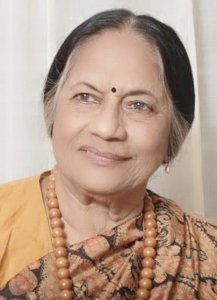 Kumudini Lakhia 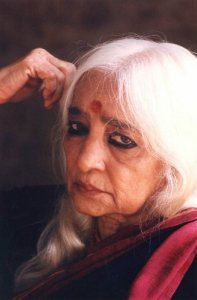 Chandralekha (Photo: Sadanand Menon) Coming out of the above proposition, this critic would next propose that the traditional dances should look up to their own times for developing contents with changed imagery, metaphors and paradigms as the other art forms have done already. There have fortunately been illustrious torch-bearers in traditional dances, which have shown the way. Mrinalini Sarabhai staged choreographies against rapes, Adivasis and rampant pollution of nature as in the Ganga. Kumudini Lakhia discarded "Kathak with Krishna" altogether and went on to create Jugal, Sanbhav, Coat and Atah Kim. Chandralekha boldly took up women's themes, brought in Yoga and Kalaripayattu into Bharatanatyam and made out her oeuvre from Shree to Sharira. From the new generation, Rama Vaidyanathan has created the entire Margam - from Alarippu to Tillana - on bird life and their transmigration, after joining hands with the avid bird watcher Arshiya Sethi. Akram Khan from Bangladesh has taken forward the scent of his native soil to England and blended Kathak with western dance to create his winning choreography Bhumi. Ileana Citaristi - trained by Augusto Boal in "Poor Theatre" in Poland - has created an eye-opener item Refugees, highlighting the sad plight of homeless refugees like Rohingyas and other migrants from all over the world. Many others -- like Anita Ratnam and Geeta Chandran - have forayed into the modern idiom, but these exceptions should only prove the norm! 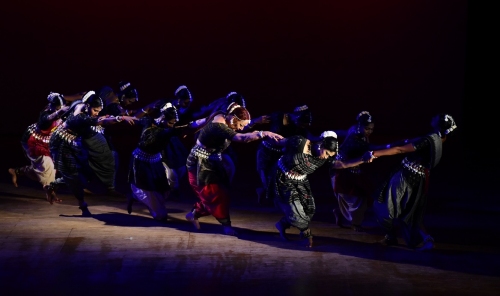 Ileana Citaristi and dancers in 'Refugee' 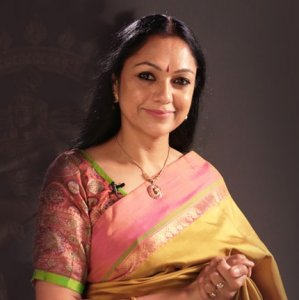 Rama Vaidyanathan 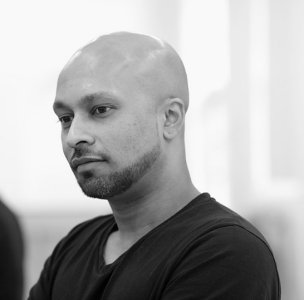 Akram Khan Finally, this critic would submit that Nava Rasas have brilliantly served their purpose and we now need new myths and symbols to transcreate the Rasas for our fractured times. He would suggest some six new Rasas: to make a tally of Panchadasa Rasas, if not more. On top of the list should be Ecstasy, to express elation of excellence, enthusiasm for high performance. Then there should be Joy for simple, homely pleasures of life. Then can come Courage against social tyranny, military oppression and political witch-hunting. Next can come Resistance of the femininity against male chauvinism, the right to say NO against an overarching patriarchy. Pen-ultimately can come Despair, desperation of the immigrant skilled labour pouring on the roads for return home; anguish of the starving peasants unable to repay their loans. And ultimately, there should be Gloom, the deep depression of a luminous dancer like Ranjabati Sircar, who - just a few months before she ended her life - shed tears at home before this critic on how established dancers were preventing her to dance her brand of Naba Nritya; the sense of doom of Sushant Singh Rajput - a brilliant drama student under Ebrahim Alkazi from his last institution, The Living Theatre -- who ended his career on drugs or depression, one does not know yet. This critic -- without having the benefit of prior consultation -- would recommend a band of six millennial dancers to form a new "Jayantika", as it were, bonding online and using Internet, to evolve these six (or more) Rasas suiting the present age. They are all capable, uniformly brilliant, exposed to today's culture and are all "chips off the old block" not to go astray. The suggested names are: Kapila Venu, daughter of G. Venu: the most articulate spokesperson of Koodiyattam; Prateeksha Kashi, daughter of Vyjayanti Kashi, a gold medalist in Computer Science; Dakshina Vaidyanathan, daughter of Rama Vaidyanathan, having already presented exalted colonial British figures on the Bharatanatyam stage; Sharanya Chandran, daughter of Geeta Chandran, with a Graduate Degree of London School of Economics under her belt; Vijayalakshmi Shivaji, daughter of Bharati Shivaji, having already danced to Tchaikovsky's music for The Swan Lake at Bolshoi Theatre in Moscow and now US-based; and the petite Bhavana Reddy, daughter of Raja-Radha Reddy, having already composed Western music in the USA and having shown her exquisite lyrics to this critic. They should hopefully bond into an excellent team of innovators! 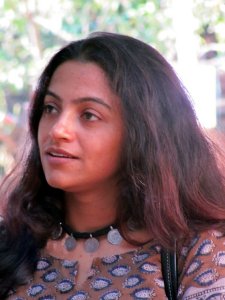 Kapila Venu 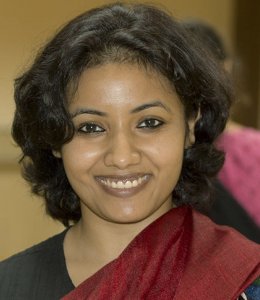 Anwesa Mahanta Continuing in this vein and before concluding, this critic would make bold so as to say that Sattriya dance, recognized by Sangeet Natak Akademi only in 1999, has yet to come out of Assam to the rest of India or the country's Diaspora in the world, and needs consolidation of innovation - using Assam's own roots to do so. He would suggest a team of two outstanding Sattriya dancers to accomplish this much-needed task - Anjanamayee Saikia, who teaches in a medical college in Guwahati, and Anwesa Mahanta, who holds a Ph. D. in "Oral Traditions of Assam" from Guwahati University. One can conclude with a quote from an unknown source: For our arts to be in sync with our lives, we must embrace the turmoil of our times and find a way to unfold it in our artistic process... Our exalted Gurus have given our dancers well-founded roots. Now let our dancers have wings to soar high in the wide open sky and fly into new shores and destinations!  Dr. Utpal K Banerjee is a scholar-commentator on performing arts over last four decades. He has authored 23 books on Indian art and culture, and 10 on Tagore studies. He served IGNCA as National Project Director, was a Tagore Research Scholar and is recipient of Padma Shri. Post your comments Please provide your name and email id when you use the Anonymous profile in the blog to post a comment. All appropriate comments posted with name and email id in the blog will also be featured in the site. |